
Andy Lloyd's Dark Star Blog

Blog 55 (October 2017)
Alien Red Asteroid Crashes Through Solar System
Astronomers using the PanSTARRS 1 telescope on Haleakala, Maui have observed a fast-moving object moving through the solar system, at a speed of about sixteen miles per second (1). The object's appearance is that of a point of light in the sky, rather like a star, so it is now thought to be an asteroid rather than a comet, which would have formed a coma of expunged volatile gases as it move into the vicinity of the Sun. The speed with which the object is moving is well beyond that of a regular, orbiting object in the solar system. At the distances involved, the object is moving faster than the escape velocity of the Sun, and so is now heading out of the solar system on what astronomers call a hyperbolic orbit - it's moving too fast for the Sun to have captured or retained it (2).
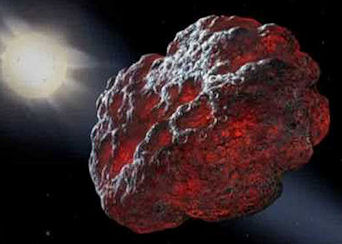
Image credit: Kurdistan Planetarium
The object has now been given the designation A/2017 U1 ('A' for asteroid, although the original designation by the Minor Planet Center labelled it as a comet: C/2017 U1 (PANSTARRS) (3)). A/2017 U1 entered our solar system from the direction of the solar apex, in the northern celestial hemisphere, then passed within Mercury’s orbit and crossed the ecliptic, achieving perihelion some 23 million miles from the Sun on 9th September. Following its perihelion passage in the southern celestial hemisphere, it crossed back through the ecliptic along its rapid outward trajectory, travelling at 27 miles per second towards the constellation Pegasus.
A/2017 U1 is now thought to be the first example of an interstellar asteroid or comet observed traversing the solar system. The route it took through the solar system did not bring it close to any of the planets, which might have sling-shot a regular solar system comet into the hyperbolic orbit observed in this case:
“When we run the orbit for this [object] back in time, it stays hyperbolic all the way out – there are no close approaches to any of the giant planets that could have given this thing a kick,” he said. “If we follow the orbit out into the future, it stays hyperbolic,” [Dr Gareth] Williams [associate director of the Minor Planet Center] added. “So it is coming from interstellar space and it is going to interstellar space.” (4)
This is supported by the direction from which A/2017 U1 came from. It originated from a point in the sky near to the star Vega, and very close to the direction the Sun itself is heading towards in interstellar space.
"...A/2017 U1 is coming from a spot only 6° from the solar apex, the direction that our Sun is moving (at about 20 km/s) through its interstellar neighborhood and thus, statistically, the most likely incoming direction for an interstellar visitor." (1)
So, this object is a bit like a gnat flying along a road directly into the windscreen of an oncoming car. This particular gnat is a reddish colour, and, according to astronomers, very likely came from another star system. Even though it originated from the general vicinity of the star Vega, it probably didn't start life there. Vega, too, is moving along its own trajectory as it circumnavigates the centre of the Milky Way galaxy, which changes its position in the sky relative to us over time. If A/2017 U1 had been ejected from the Vega system then, at its current velocity, it would have begun its journey 300,000 years ago. At that time, Vega was some distance away from where its is now. More likely, then, A/2017 U1 is simply an interstellar lump of rock of unknown origin which has, quite by chance, ended up flying through the planetary zone of the Sun.
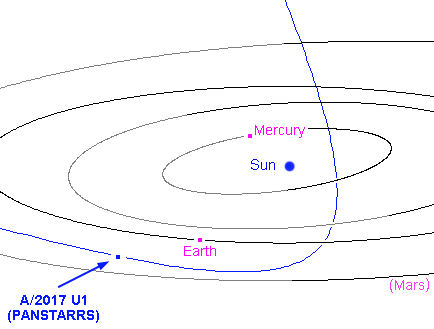
Image credit: NASA / JPL / Horizons
Its closest approach to the Earth was 15 million miles away, which occurred on 14th October 2017, during its outward journey away from the Sun. Astronomers were able to image the object and obtain a spectrograph of the light from it, indicating that it has a reddish hue (which may possibly indicate the presence of organic materials on its surface).
A/2017 U1 appears to have a composition similar to a typical Kuiper Belt Object, but with the added twist that it originated from another star system. Many of the known Kuiper Belt Objects are tinted red. This is thought to be due to the fierce action of solar radiation on surface, or sub-surface ices (5). Pluto has a reddish pink tint, too, displaying a diversity of surface features indicative of a complex, possibly violent, history (6).
However, that itself raises the issue of why the volatiles usually associated with such a cold, distant object were not driven off by its encounter with the Sun. If the object is derived from the outer zones of any star system, then it should really have behaved more like a comet than an asteroid. The object seems to be pre-stripped of volatile ices. In which case, it must have originated from an inner part of another star system. But it cannot, by definition, be a returning solar system comet which has already had its volatiles driven away by a prior perihelion passage around the Sun. Because, if that was the case, then how can its rapid incoming, solar system-escaping velocity be explained?
More likely then, this object is an ejected rocky exo-asteroid which originated from within the 'frost line' of its home star system. There is a precedent for reddish asteroids in our own system - the so-called P-type asteroids, which are a collection of dark, reddish asteroids in the outer asteroid belt which appear to have coatings of kerogen-related organic compounds. These objects indicate that some water-based surface chemistry has taken place in the past, and so they likely have some water ice contained within their interiors. So, again, with respect to this precedent, I wonder how it is that A/2017 U1 has both a reddish tint (indicating surface organics) but has not driven off its water ices during perihelion?
An Emissary from Planet X?
There is another possibility that has not yet been considered by astronomers. My research colleague, Al Cornette, has posted an intriguing idea on the Dark Star Planet X group. Could this object have received a slingshot from another planet in the solar system - one which astronomers have not yet spotted?
"Something strange about this comet/asteroid. Could a close encounter with Planet X as it was orbiting in the asteroid belt location and getting a sling shot boost, explain its extreme orbit." (7)
Could A/2017 U1 have been flung towards the Sun by a close encounter with Planet X? If so, then it need not be an interstellar object at all. Instead, its direction of origin, near to the solar apex of the solar system, might give us a very strong clue as to the location of a distant Planet X object, or even a binary Dark Star hidden among the outer comet clouds. In fact, I described this possibility in my 2005 book, 'Dark Star', when discussing the Sun's potential 'wobble' along a hypothetical binary axis with a massive companion object:
"We know that the sun is moving in a slightly odd direction compared with its neighbours. It is heading towards the Solar Apex, near the star Vega in the sky, and this may turn out to be coincident with the position of the Dark Star." (8)
My argument is that exoplanets are now routinely discovered by detecting a wobble in the parent star's position, due to the gravitational effect of the hidden planet orbiting around it. If our Sun had its own wobble as a result of the gravitational attraction of a massive companion object in a distant orbit around it, then we would notice it only through a change in the Sun's own position in space with respect to the stars in our cosmic neighbourhood. That relative motion in space, therefore, might account for the Sun's current direction of travel - towards the solar apex.
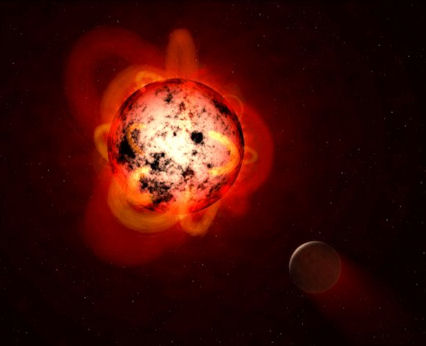
Image Credit: NASA, ESA, and G. Bacon (STScI)
So, if A/2017 U1 is an object from the outer solar system which has plunged rapidly down towards the Sun as a result of a slingshot encounter with the Dark Star (a sub-brown dwarf companion) located near to the solar apex, as Al suggests, then this would fit neatly into that broader scenario. In which case, we should be paying particular attention to that area of the sky if wishing to locate such a companion object. The red asteroid A/2017 U1 could turn out to be an emissary sent to light the way.
However, if A/2017 U1 did originate from the outer solar system, and was perturbed into its rapid descent towards the run by an encounter with a massive Planet X body, then one would expect this object to still behave like a comet. It, too, should be a semi-icy body capable of expelling volatile gases as it approaches the Sun. There are a couple of fairly outrageous possibilities to explain this:
Firstly, an encounter with a sub-brown dwarf among the comet clouds might have been sufficiently traumatic to drive off the object's volatiles before its later encounter with the Sun.
Secondly, the object might have originated from the Dark Star system itself, in which case it would be asteroidal in nature by definition (being a member of the sub-brown dwarf's original family of planets/moons/asteroids).
Thirdly, perhaps A/2017 U1 resulted from a deep space collision, the force and heat of which drove off the interior volatile ices, producing a fast-moving lump of rock.
These all seem to be low probability events, but each one could explain the 'dead' nature of this incoming object. In the end, even though the behaviour of this interloper remains somewhat mysterious, it seems most likely that this object is 'just' an interstellar asteroid. I say 'just': It is, after all, the first ever comet to be designated as an asteroid, and, once confirmed, the first ever interstellar comet/asteroid to be observed.
Written by Andy Lloyd,
28th October 2017
References:
1)
Kelly Beatty "Astronomers Spot First-Known Interstellar “Comet”" 25 October 2017, with thanks to Lee2) NASA/JPL 'Small Asteroid or Comet 'Visits' from Beyond the Solar System' 26 October 2017
3) Minor Planet Center "COMET C/2017 U1 (PANSTARRS)" 25 October 2017
4) Nicola Davis "Mysterious object seen speeding past sun could be 'visitor from another star system'" 27 October 2017
5) Karen Fox 'Kuiper Belt of Many Colors' 27 October 2010
6) Charles Choi 'Did Pluto's Weird Red Spots Result from Crash That Spawned Charon?' 30 January 2017
7) Al Cornette "Re: The Solar System Just Had an Interstellar Visitor. Now It’s Gone" 26 October 2017
8) Andy Lloyd "Dark Star: The Planet X Evidence" p23, Timeless Voyager Press, 2005
A Tale of Two Airports
One of my correspondents sent me some information about this story, which he had come across recently, and which I knew nothing about. I thought I'd share this with you, and the little rabbit hole this led me down...
It's a brave politician indeed who stands up in front of the press and talks about ancient aliens. We're all proud of the heritage of our own countries, and why shouldn't the Iraqis be an6y different to the rest of us? After all, the first great civilisation, Sumer, crystallised out of pretty much nothing about 6000 years ago in the lands now known as Iraq, in the plain between the mighty Euphrates and Tigris rivers. Sumer introduced many of the features of modern civilisation we still benefit from today. Their early achievement included the development of cuneiform script, a mind-wrenchingly complex numerical system, the rule of law, a complex economy, medicine, architecture on a grand scale, urbanisation, and the first great creation epics and poems. They also worshipped a pantheon of gods, to whom they attributed their received knowledge.
It has often been wondered how such a remarkable civilisation could have emerged so rapidly, as if from nothing. Now, it is recognised that earlier civilisations were around in the Levant, for example, the people who built Göbekli Tepe in Turkey, thousands of years before the emergence of Sumer in lower Mesopotamia. The cradle of civilisation may have already been in train elsewhere. Even so, the remarkable nature of the Sumerian society has caused some scholars to ponder whether the Sumerian myths might literally be true - that their knowledge was actually passed down by 'the gods'.
This idea, which has been around for a very long time now, was publically discussed by the Iraqi Transport Minister, Kadhum Finjan Al-Hamami this time last year, on the occasion of the opening ceremony of a new airport in Nasiriyah, in the southern Iraqi province of Dhi Qar (1).
https://twitter.com/Hayder_alKhoei
He was speaking to an assembled group of reporters, and described how an airport had first been built on that very site 7000 years before.
“The first airport that was established on planet earth was in this place,” said Mr Finjan, according to the site Memo: Middle East Monitor. Memo reported that the minister also claimed that the angels “were all Sumerian” and “Sumerian spaceships used to launch from here towards the other planets.” (2)
The Minister's remarks appear to have gone unchallenged at the airport opening ceremony itself, but received a barrage of criticism and mockery when the video was released out onto social media (3). The remarks, which took on a certain notoriety, were still being quoted by Middle Eastern journalists six months later (4). Mr Al-Hamami apparently referred to the writings of Dr Samuel Kramer, an Assyriologist at the University of Pennsylvania, who died in 1990, and who was a foremost authority on Sumer.
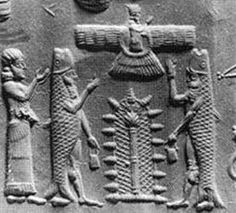
On the face of it, Dr Kramer provided a very down-to-Earth assessment of life in ancient Sumer:
"In scholarly articles and some 30 books for both academic and popular audiences, Dr. Kramer portrayed the Sumerians as people not very different from those in modern societies. They worked hard to earn a living, worried about their children, argued with each other about land and business and did not like to pay taxes. He discovered and enjoyed quoting one of their proverbs: "You can have a lord, you can have a king, but the man to fear is the tax collector."" (5)
But his work was centrally important in introducing the many Sumerian achievements to the world, and placing their emerging mythologies and cosmogonies in their rightfully preeminent historical place:
"Whatever little is known of Sumerian mythology is largely surmised from the modified, redacted, and in a sense, garbled versions of the Babylonians who conquered the Sumerians toward the very end of the third millennium B. C., and who used the Sumerian stories and legends as a basis and nucleus for the development of their own myths. But it is a known fact that in the long stretch of time between approximately 3500 and 2000 B. C. it was the Sumerians who represented the dominant cultural group of the entire Near East. It was the Sumerians who developed and probably invented the cuneiform system of writing; who developed a well integrated pantheon together with spiritual and religious concepts which influenced profoundly all the peoples of the Near East; who, finally, created and developed a literature rich in content and effective in form." (6)
Kramer's many books about Sumer, mostly written in the 1950s and 1960s, were subsequently quoted by the maverick scholar Zecharia Sitchin, whose own writings from the mid-1970s onwards developed the ancient astronaut theme around the fabled 'Anunnaki' (7). Sitchin argued that the Sumerian cosmology evident within their creation epics and clay tablet illustrations described the solar system as we now recognise it, but with an additional planet, which he identified as 'Nibiru-Marduk, after the Babylonian god. In this way, Sitchin argued that knowledge of even the planet Pluto lay within Sumerian scientific knowledge - a situation utterly impossible unless they had advanced technologies to rival our own, or had received knowledge of this small distant world from visiting ancient astronauts (the Anunnaki). It is this correlation which seems to have driven the Iraqi Transport Minister's remarks, rather than the more prosaic writings of Dr Samuel Kramer.

Irrespective of this confusion, I personally find it remarkable that a public figure in the Middle East feels comfortable, indeed safe, to discuss his beliefs about ancient astronauts in this way. After all, the old polytheistic religions of Babylon, Assyria, Akkad and Sumer no longer sit easily alongside the overwhelming power of monotheistic Islam in Iraq. To be seen to take these myths seriously, to stand out publically in a Muslim country and speak of ancient technologies and space travel by the ancient Sumerians, is to invite great ridicule. Which makes me wonder whether Kadhum Finjan Al-Hamami's viewpoint is just the tip of the iceberg within the higher echelon of Iraqi society. His heresy may be more widely held than many imagine.
Written by Andy Lloyd, 7th
October 2017
References:
1)
April Holloway "Iraqi Transport Minister Announces that Sumerians Launched Spaceships 7,000 Years Ago" 4 October 2017, with thanks to Jim2) Katie Forster "Iraqi transport minister claims first airport was built 7,000 years ago in Iraq by ancient Sumerians" 1 October 2017
3) Middle East Monitor "Iraqi transport minister’s 7,000 year airport claim mocked" 1 October 2017
4) Wassim Bassem "So many Iraqi airports, so few planes" 20 April 2017
5) John Noble Wilford "Samuel Noah Kramer, 93, Dies; Was Leading Authority on Sumer" 27 November 1990
6) Samuel Noah Kramer "Sumerian Mythology: A Study of Spiritual and Literary Achievement in the Third Millennium B.C." Revised Edition, Philadelphia, Pennsylvania: University of Pennsylvania Press, 1961,
7) Zecharia Sitchin "The Twelfth Planet" Avon Books 1976
Planet Nine and the Nice Model
It looks like it'll be another long, quiet autumn for Dr Mike Brown and Dr Konstantin Batygin on the summit of the Hawaiian dormant volcano Mauna Kea, searching for Planet Nine. They made use of the 8m Subaru telescope last year, and it looks like they were back again this year for a second role of the dice. I can only assume, given the time of the year, that the constellation of Orion remains high on their list of haystacks to search. Dr Brown has indicated that his team is narrowing down the search area through the use of countless computer simulations, but not much beyond that in terms of exactly where (1). Probably because he doesn't really know himself at this stage. More on their hopes for a breakthrough in a moment.
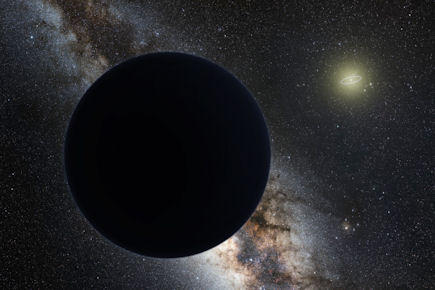
Image credit: ESO
A recent article neatly sums up the current state of play with the hunt for Planet Nine (2), bringing together the various anomalies which, together, seem to indicate the presence of an undetected super-Earth some twenty times further away than Pluto (or thereabouts). Given how much, I've written about this materials already, it seems unnecessary to go over the same ground. I can only hope that this time, Dr Brown and his erstwhile colleague, Dr Batygin, strike lucky. They have their sceptical detractors, but the case they make for Planet Nine still seems pretty solid, even if the gloss has come off it a bit recently with the additional OSSOS extended scattered disk object discoveries (3). But there's nothing on Dr Brown's Twitterfeed to indicate what his plans are regarding a renewed search for Planet Nine.
Even if the Planet Nine article's discussion about a new hunt for the celestial needle in the haystack is misplaced, it does make a valid point that super-Earths, if indeed that is what this version of Planet X turns out to be, are common enough as exo-planets, and weirdly absent in our own planetary backyard. So a discovery of such an object way beyond Neptune would satisfy the statisticians, as well as get the bubbly flowing at Caltech. Dr Brown did seem to think that this 'season' would be the one. We await with bated breath...
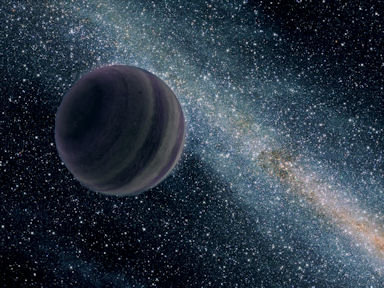
Meanwhile, the theoretical work around Planet Nine continues, with a new paper written by Konstantin Batygin and Alessandro Morbidelli (4) which sets out the underlying theory to support the result of the 2016 computer simulations which support the existence of Planet Nine (5). Dr Morbidelli is an Italian astrophysicist, working in the south of France, who is a proponent of the Nice model for solar system evolution (named after the rather wonderful French city where he works). This model arises from a comparison between our solar system's dynamics, and those of the many other planetary systems now known to us, many of which seem bizarre and chaotic in comparison to our own. Thus, the Nice model seeks to blend the kinds of dynamical fluctuations which might occur during the evolution of a star's planetary system with both the outcomes witnessed in our own solar system, and the more extreme exoplanets observed elsewhere (6). It invokes significant changes in the positions of the major planets during the history of the solar system, for instance. These migrations have knock on effects which then drive other disturbances in the status quo of the early solar system, leading to the variations witnessed both here and elsewhere. For instance, Dr Morbidelli lists one of the several factors which brought about the Nice model:
"One would expect that the Solar System evolved gradually, from a primordial chaos characterized by mutual collisions and ejections of bodies, to the current state of essentially regular orbital motion; however, the terrestrial planets, the asteroids and, possibly, the satellites of the giant planets, carry the scars of a “Late Heavy Bombardment” (LHB), suddenly triggered 600 million years after planet formation, or approximately 3.9 Gy (Giga-year = billion years) ago. This argues for a sudden change in the structure of the Solar System, so that a stable reservoir of small bodies became unstable and its objects started to intersect those of the planets and collide with the latter". (6)
Now, I'd argue that this event was caused by the arrival of an external interloper - a rogue planet which is either a free-floater from interstellar space, or a distant companion object which had been nudged into the planetary zone of the solar system. Either way, the outcome was catastrophic. This object may be Planet Nine. Or, it may be a Nemesis like object, a sub-brown dwarf invading from the distant reaches of the solar system, and unsettling the planetary apple cart. The purpose of the Nice model, however, seeks to theoretically explain both the outcomes seen in our system, and the very different patterns of planetary distribution observed elsewhere (e.g. 'hot Jupiters'). So, Morbidelli might argue that planetary migrations are not only sufficient in this case, but create a common plausible scenario which can be rolled out elsewhere, too:
"...the simulations of the new Nice model, when they fail to reproduce our own system, often lead to planetary systems similar to some of those observed around other stars, with very eccentric planets or planets that remain in resonance forever. Thus, the great diversity among planetary systems seems to stem not from a diversity of processes, but from the diversity of outcomes under the same processes." (6)
In which case, no need for the appearance of an external interloper. In return, I'd argue that the very difference between our system and others is exactly because of the interjection of an external interloper, radically shaking things up at the point of entry and for a considerable period of instability thereafter. In which case, no need for the rather Byzantine complexity of the Nice model.
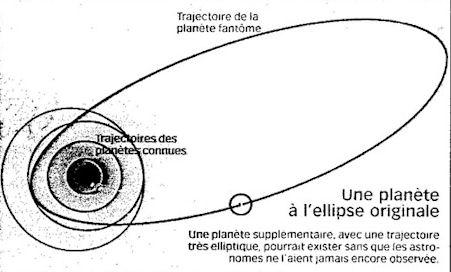
Image credit: (7)
Anyway, back to Planet Nine. Alessandro Morbidelli has had more than a passing interest in Planet X for a very long time. I first wrote about his interest in the subject back in 2004, when the discovery of Sedna began to rock the astrophysics world (7). Dr Morbidelli and Harold Levison considered a number of scenarios which might explain Sedna's unbelievable orbit, including the passage of a brown dwarf through the early solar system, and the existence of an as-yet undiscovered massive planet beyond Neptune, among other ideas (8). The computer simulations which were worked up from these hypotheses emerged around the same time as an article in a French magazine which interviewed the Italian astronomer from Nice, and included a diagram of the orbit of a possible Planet X (9) which could have been picked straight out of a book by Zecharia Sitchin.
This new paper by the astrophysics pair is not an easy read, for sure. It discusses the dynamical relationships between anomalous bodies in the outer solar system and Planet Nine, particularly with respect to resonance relationships which might maintain the stability of these patterns over the long-term. It aims to show how the dynamical evolution of the trajectories of these anomalous objects over the lifetime of the solar system may have been driven by the presence of this undiscovered super-Earth. This is a purely theoretical analysis, aimed at shoring up the results from simulations, and observations with an underlying basis in physics, covering these three main areas:
Orbital clustering of long-period Kuiper belt objects
The dynamical detachment of KBO orbits from Neptune
The generation of highly inclined/retrograde bodies within the solar system.
All of these points were looked at in Batygin and Brown's original Planet Nine paper (5), which attempted to model these observed effects using computer simulations. The general thrust of the answers provided in this new theoretical paper might be succinctly summed up by the Facebook status phrase "It's complicated...". Those are the kinds of relationships we're dealing with here.
In a footnote in the first page, the paper does set out a very clear explanation of what sets the Planet Nine work above and beyond the original work on the extended scattered disk patterns first explored by Trujillo and Sheppard in 2014 (10) (a question I have raised with a number of astrophysicists whilst researching my new book):
"The Planet Nine hypothesis was inspired by the work of Trujillo & Sheppard (2014), who noted that the arguments of perihelion (the angle between the apsidal and nodal lines on an orbit) of distant Kuiper belt objects are grouped together. In contrast with this finding, the primary aim of Planet Nine’s inferred influence is to explain the simultaneous clustering of the longitudes of perihelion (a proxy for the direction of the pericenter in physical space) and the longitudes of ascending node (orientation of the orbital plane)." (4)
This is quite technical, but provides a reasonable clarification of what Batygin and Brown brought to the astrophysics table that was new.
Another item that jumped out at me was the brief discussion of how the Sun's obliquity (of about six degrees) might be accounted for by Planet Nine - this is one of the five main threads of evidence supporting this highly inclined, super-Earth Planet X object. The paper cites earlier work of one of the co-authors which pondered whether this obliquity might have been caused by the early presence of a binary companion to the Sun (11). Hmmm...
Speaking of Konstantin Batygin, he blogged about the Caltech team's renewed search for Planet Nine earlier this month, and remains hopeful that the frustratingly elusive trans-neptunian planet will eventually be discovered:
"Mike [Brown] and I just spent a week at 14,000ft on the Big Island directly searching for Planet Nine, and I’ve been thinking a lot about how Popper’s falsifiability criteria apply to the Planet Nine hypothesis… Obviously, if we search the entire sky at sufficient depth and don’t find Planet Nine, then we are plainly wrong. But I don’t think this is going to happen. Instead, I think we (or some other group) are going to detect Planet Nine on a timescale considerably shorter than a decade - maybe even this year if we/they get lucky." (12)
Let's hope it pops up before the technical explanations for its existence get even more complex...
Written by Andy Lloyd,
11th-22nd October 2017
References:
1
) Mike Brown "Planet Nine: where are you? (part 1)" 21 September 2017findplanetnine.blogspot.com/2017/
2) Pat Brennan "The super-Earth that came home for dinner" 4 October 2017, with thanks to John
3) Andy Lloyd "Planet Nine: Are They Digging in the Wrong Place?" 3 July 2017
andylloyd.org/darkstarblog52.htm
4) Konstantin Batygin & Alessandro Morbidelli "Dynamical Evolution Induced by Planet Nine" 6 October 2017
5) K. Batygin & M. Brown "Evidence for a Distant Giant Planet in the Solar System" The Astronomical Journal, 151: 2, 20 January 2016,
6) Alessandro Morbidelli "Review: A Coherent and Comprehensive Model of the Evolution of the Outer Solar System" 28 October 2010,
hal.archives-ouvertes.fr document
7) Andy Lloyd "Alessandro Morbidelli and the Origin of Sedna" 15 November 2004,
darkstar1.co.uk/Morbidelli.html
8) A. Morbidelli & H. Levison "Scenarios for the origin of the Orbits of the Trans-Neptunian Objects 2000 CR105 and 2003 VB12 (Sedna)" The Astronomical Journal, 128: pp2564–2576, 2004
9) V. Greffos “PLANETS – But How Many Are There In Our Solar System?” Science & Vie, Feb 2003
10) Chad Trujillo & Scott Sheppard "A Sedna-like body with a perihelion of 80 astronomical units", Nature, 2014, 507, pp471-4
11) Konstantin Batygin "A primordial origin for misalignments between stellar spin axes and planetary orbits" Nature, 2012, 491, pp418-20
12) Konstantin Batygin "Theory" 10 October 2017 (no longer available online)
The Red Sun Phenomenon
The word 'eerie' really didn't do it justice. On the 16th October, I was privileged to witness a rare meteorological phenomenon. Several hundreds of miles to the west of where I was, the dampening tropical storm that had been the Atlantic Hurricane Ophelia was battering Ireland. The hurricane had dragged up dusty air from the Sahara, and smoke from forest fires in Portugal, at it travelled towards the British Isles. These fluctuating, brooding clouds swept across the country, buffeted by the strong, dry winds. And within these ominous clouds, the sun turned red.
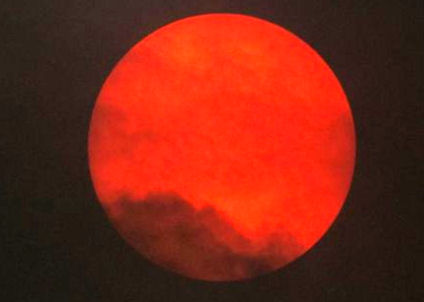
It looked like the kind of special effect you might expect to see in a
Hollywood movie about an impending apocalypse. It also lasted for
hours. I first saw the red sun late morning from my office window,
and then had to drive from Gloucester down to Swindon. It remained
ominously red for the entire trip, creating strange yellow light effects
across the autumnal English landscape. Within this reddish gloom,
I had plenty of time to reflect on my two decades of research and
writing about the phenomenon that is 'Nibiru' - the mysterious red star
of the Babylonian astrolabes which has become such a feature of Planet X
study and debate. I thought of the red star in alchemy, the
transitioning of light in the great work, which had once captured my
imagination as an esotericist:
"Speaking of the circular work and its fuel, an
alchemist says: 'The fire is enkindled by an invisible sun unknown to
many, that is, the sun of the philosophers'..." (1)
Some, naturally, associated the midday red sun phenomenon with Nibiru directly, sparking a rash of sensationalist articles in the UK tabloid press (2, 3).

Such was the furore generated by these excitable
hacks that Nibiru was subsequently mentioned on the BBC's satirical news
quiz 'Have I got News For You?' (4). All good fun, of
course, but these kind of omens do pack quite a bit of a psychological
punch. With Brexit looming large here in the UK, and with the
stability of the world sorely tested right now by brinkmanship across
continents, one could be forgiven for pondering our collective futures.
All we need now is the mother of all comets!
Written by Andy Lloyd,
References:
1
) Andy Lloyd "The Red King and the Rubedo" 14 December 20012) Tom Towers "Is THIS Nibiru? Terrifying red sun spotted above UK sparks APOCALYPSE fears" 16 October 2017
3) Jon Austin "NIBIRU ALMOST ON US? 'Sky and sun change colour in sign of Planet X and end of the world'" 16 October 2017
4) BBC "Have I got News For You" 20th October 2017, Series 53, Episode 3, at 12th minute,
A Witch's Honour
Whilst reading the introduction to a book I've been reviewing this month, I was stunned to see myself quoted, at length! It appears that my review of one of this author's previous titles struck a chord with her.
Melusine Draco introduces my review passages with this preamble:
"It was Andy Lloyd Books Reviews that first put the Traditional Witchcraft series into its proper perspective."
I clearly have an affinity with her material. Does this actually make me a witch, though? Friends of mine suggested trying the ducking stool test just to find out for sure. But since they're now all newts, I daresay my secret is safe for a while longer. Happy Hallowe'en!
You can read my reviews of these books here:
'Traditional Witchcraft for the Seashore' by Mélusine Draco
'Traditional Witchcraft and the Path to the Mysteries' by Mélusine Draco

You can keep informed of updates by following me on Twitter:
![]()
Or like my Facebook Page: https://www.facebook.com/darkstarandylloyd